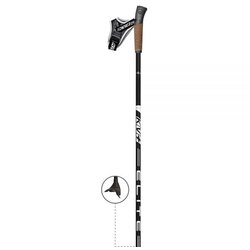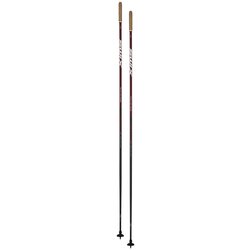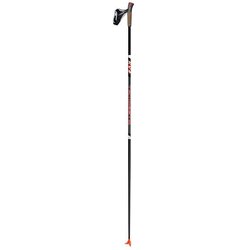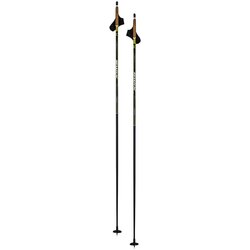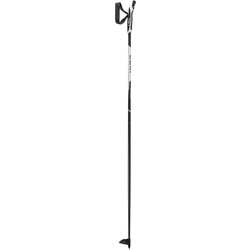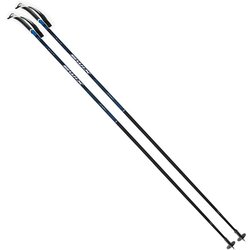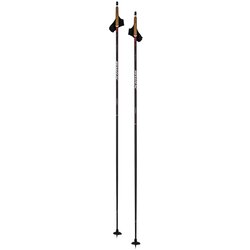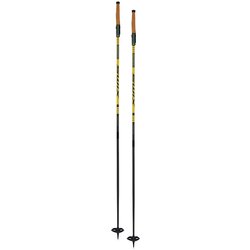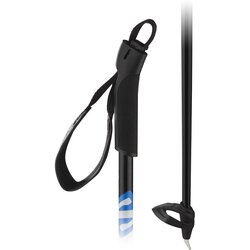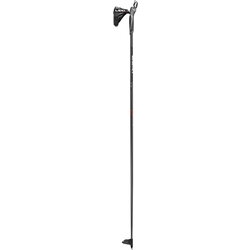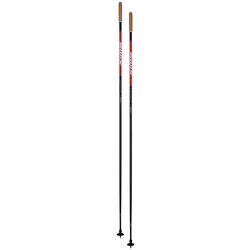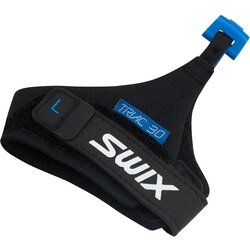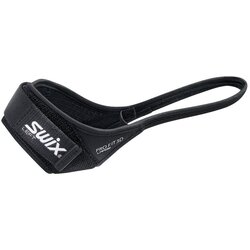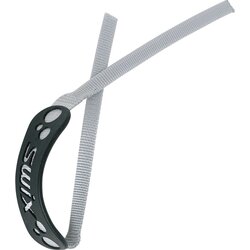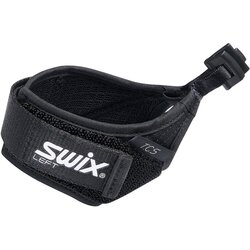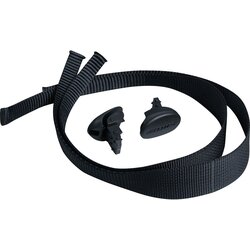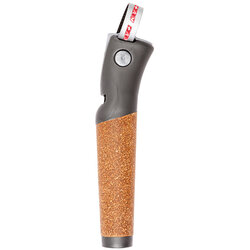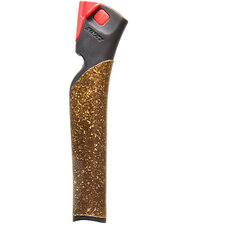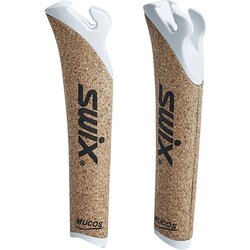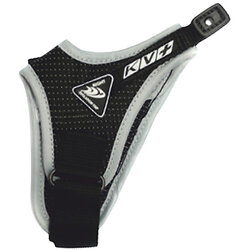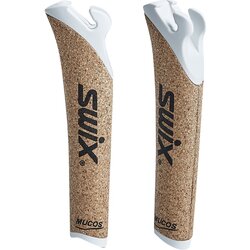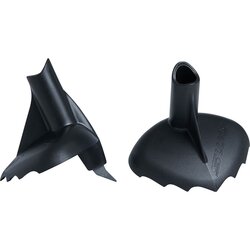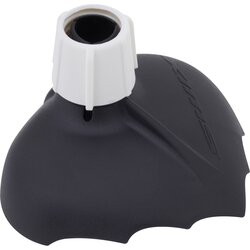Buyer's Guide: XC Ski Poles
The 4 Components of XC Ski Poles
Choosing the right ski pole comes down to thinking about where and how you are going to ski. For example, skate ski poles will be longer, stiffer, and lighter than backcountry poles. With this guide, we hope to pick out the right pole for your needs by thinking about the different parts of a ski pole.
Rough sizing is pretty straight forward. Classic poles should be taller than the armpit but below the shoulder. Skate poles should be between the chin and the nose. A chart for more precise sizing is at the bottom of this article.
There are four basic parts of a cross-country ski pole. Starting from the bottom, these are the basket, the shaft, the grips, and the strap. Each plays an important part in what makes a quality pole.
The Shaft it the Most Important Component of Any Pole
The shaft of the ski pole determines how much the pole will flex or its stiffness. The longer a ski pole gets, the more important stiffness becomes. Common sense tells us that longer things bend easier. Usually, taller skiers are also heavier, so they require a more supportive pole. The more a pole bends, the less power is transmitted into propelling the skier forward. A stiff pole makes your skiing more efficient, as you lose less energy to bending the pole.
The shaft is also the main factor in determining weight. Weight may seem insignificant, however the pole is often held fully extended behind you and that this weight can act as a lever. As skiers can repeat this motion 10 000+ times in one ski, pole weight is an important factor.
There are two main materials used in ski poles. Aluminum poles tend to be inexpensive and durable. So if you are new to skiing, or are skiing in the backcountry, these can be a great choice, as bent poles can mostly be bent back straight if you fall on them. Composite poles, although durable and resilient, cannot be bent back into shape after an accident, and are a better choice for those skiing groomed trails. Composite shafts are made of strands of carbon and/or glass fibres held together with a resin. The quality of the resin and ratio and quality of the carbon and glass fibres used determine the weight, stiffness, and price.
Entry level aluminum poles will start around $50 and will often have larger baskets and basic straps. Avoid poles assembled using epoxy as the components cannot be replaced or repaired, forcing you to buy a new pole if an inexpensive part breaks.
Lower end composite poles will be made primarily of fibreglass. At around $100 composite such as the Swix poles can be quite stiff, but this will come at a slight weight penalty, or will be quite light but a little soft for racing. These poles are a great choice for a recreational classic skier.
Approximately $200 will get you an entry level racing pole, such as the Swix Quantum 3 or KV+ Tempesta. Entry level racing poles should be a consideration for most skate skiers, as this technique requires a longer pole. You may start to see full carbon poles in this price range.
$400-500 will get you a high-modulus carbon pole you can rely on for classic race starts and often include features such as quick change baskets. The $600 Swix Traic 3.0 is the lightest and stiffest pole on the market, and also features aerodynamic shaping for quick pole recovery and improved performance on windy days.
Grips and Straps help with Comfort and Warmth
Grips and straps should be considered together. The most basic poles will come with a simple loop style strap that can be adjusted. Most poles will come with a glove style strap, that is easier on the hands and elbow, and distributes poling forces more evenly, allowing for better power transmission. Most skiers find glove style straps more comfortable.
The strap attaches to the grips usually using a looped strap with a wedge. Grips will either be plastic and rubber, or plastic and cork. Plastic grips will often be epoxied to the shaft, meaning that they cannot be replaced. Cork grips are usually glued on allowing skiers to choose from an array of replacement strap and grips. Cork grips resist cold better than plastic, helping to keep your hands warm.
There are a number of proprietary systems that allow for the quick release of the straps from the grip. Many people enjoy quick release straps which make it easier to get your pole off to help your kids, or get a drink. The disadvantage is that such systems limit you to replacement parts from one manufacturer, unless grips and straps are changed together, which can present a challenge, say, when traveling.
Where Will this Pole Go? The Baskets Show
Baskets are usually glued on to the narrow end of the pole and include a metal tip held in place by a molded plastic basket. The tip grips snow and ice, while the basket prevents the pole from sinking too deep into the snow. If you regularly ski on ungroomed trails, large baskets are a necessity.
For those skiing mostly groomed conditions, a mid size basket will be the most versatile. Racers will typically use the smallest basket they can, as baskets add lever weight at the end of the pole, and the firm, well-groomed trails used for racing will typically not allow baskets to sink.
Some race level poles, will have quick release basket systems such as the Swix TBS system available on the Triac and some Swix Quantum poles, or select KV+ models such as the KV+ Tornado. This allows skiers to quickly change baskets depending on conditions, or even use the poles for roller skiing.
To determine what pole suits your needs best think about which of these features are important to you. Are you a racer who regularly changes baskets? Look at a Triac or KV+ Tornado. Just getting started? An aluminum pole might be the best choice.
Good poles can make an incredible difference to your skiing experience. To pick out your perfect pair of poles, consult one of our experts using the information below, or come visit us at 1291 Wellington St W.
Pole Length and Size Guide
How long should a classic cross country ski pole be? How long should a skate ski pole be? The ski pole size chart below provides a guide. A rule of thumb is that if you are between sizes, longer poles provide more pushing power, but shorter poles are easier to maneuver, so if you are new to the sport, or regularly going into the backcountry, shorter might be better.
Any quality ski shop will be able to cut poles to the length you require without adversely affecting the pole. In fact, some high end poles are sold as kits that the shop will cut to the appropriate size! We can cut almost all poles we sell between the sizes listed here if that is your preference.
Skier Height (cm) | Skier Height (inches) | Classic/Touring Pole Length | Skate Pole Length |
|---|---|---|---|
145 - 149 | 4'10" - 4'11" | 120 cm | 130 cm |
150 - 154 | 5'0" - 5'1" | 125 cm | 135 cm |
155 - 159 | 5'2" - 5'3" | 130 cm | 140 cm |
160 - 164 | 5'4" - 5'5" | 135 cm | 145 cm |
165 - 169 | 5'6" - 5'7" | 140 cm | 150 cm |
170 - 174 | 5'8" - 5'9" | 145 cm | 155 cm |
175 - 179 | 5'10" - 5'11" | 150 cm | 160 cm |
180 - 184 | 6'0" - 6'1" | 155 cm | 165cm |
185 - 189 | 6'2" - 6'3" | 160 cm | 170 cm |
190 - 194 | 6'4" - 6'5" | 165 cm | 175 cm |
195 - 199 | 6'6" - 6'7" | 170 cm | 180 cm |

